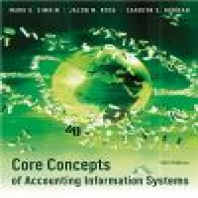12th Edition. — John Wiley & Sons, Inc., 2013. — 546 p. — ISBN 978-1-118-02230-6.The purpose of this book is to help students understand basic accounting information systems (AIS) concepts. Exactly what comprises these AIS concepts is subject to some interpretation, and is certainly changing over time, but most accounting professionals believe that it is the knowledge that accountants need for understanding and using information technologies and for knowing how an accounting information system gathers and transforms data into useful decision-making information. The book is flexible enough that instructors may choose to cover the chapters in any order.What’s New in the Twelfth Edition:
A new coauthor with an international reputation in the AIS community!
More Test Yourself multiple-choice questions at the end of each chapter to help students assess their understanding of the chapter material.
New color—both inside and on the cover! This edition uses green to highlight information and to make the book more interesting to read.
All new database chapters. Material related to the design of databases and database theory is all presented in the first database chapter, rather than spread throughout threechapters. The following two chapters describe how to apply the theoretical concepts using Access 2010. The new approach allows instructors to easily select a desired emphasis: theory, application, or both. New database diagramming methods simplify the design process for students.
Expanded coverage of topics that are increasingly important to accounting systems, including cloud computing, data mining, sustainability accounting, forensic accounting COBIT version 5, COSO’s 2010 Report on Enterprise Risk Management, enterprise controls, and internal auditing of IT.
The discussion of internal controls in Chapter 10 and auditing of IT in Chapter 12 are reorganized to reflect new PCAOB standards.
An expanded section in Chapter 1 on career paths for accountants interested in forensic accounting.
Many new Case-in-Points that identify examples of the discussion in the textbook. These examples illustrate the topic to give students a better grasp of the material.
Chapter reorganization, with database chapters moved closer to the front, as requested by our adopters. Instructors still have the flexibility to integrate the database concepts and database development anywhere in their course.
An updated glossary of AIS terms at the end of the book.
New AIS at Work features at the end of many chapters to help students better understand the impact of systems in a wide variety of contexts.
A number of new problems and cases at the end of chapters so that instructors have more choices of comprehensive assignments for students.
A new section that includes links to videos related to the concepts presented in each chapter.





















